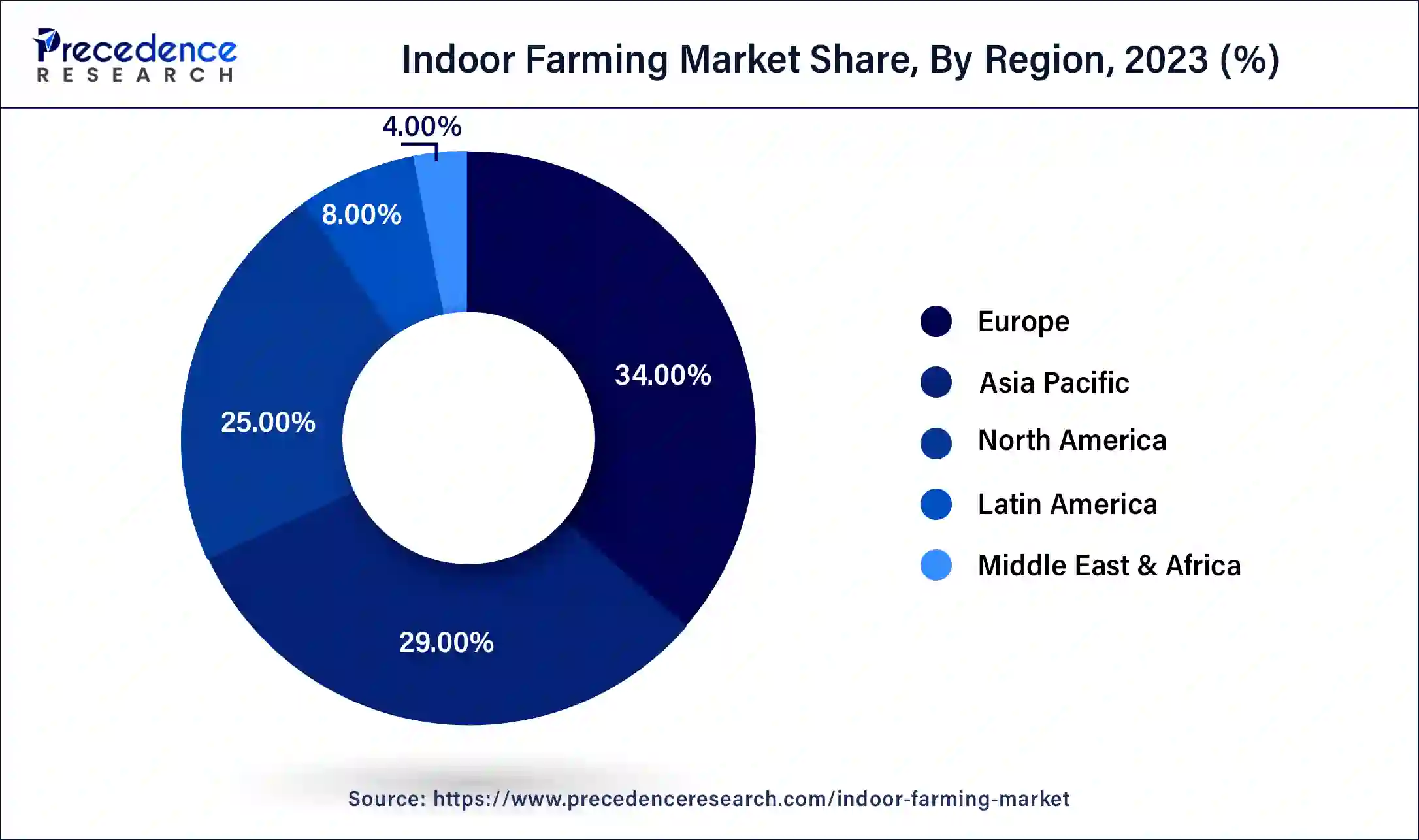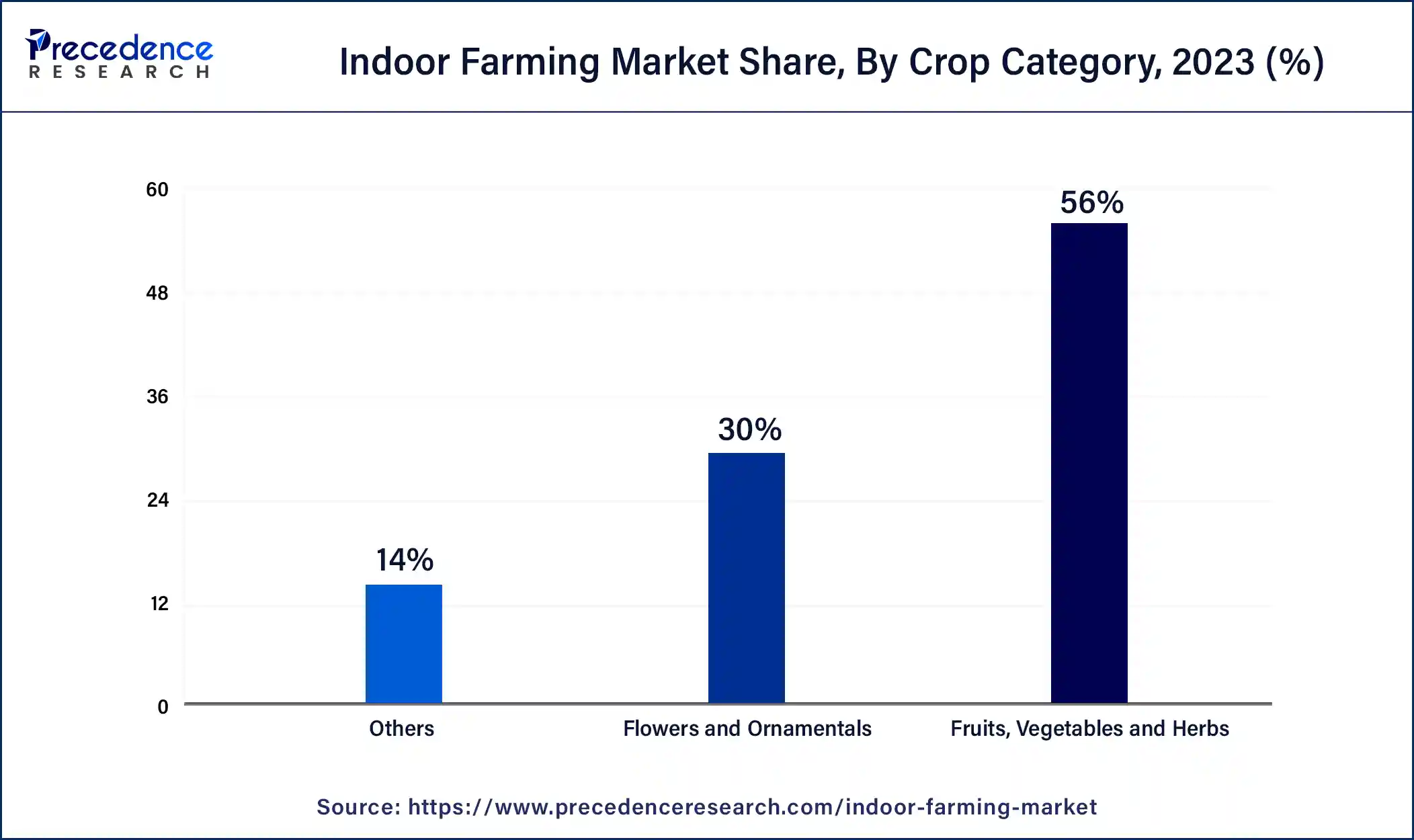The global indoor farming market size was estimated at USD 38.04 billion in 2023, calculated at USD 43.07 billion in 2024 and is expected to be worth around USD 149.07 billion by 2034. The market is slated to expand at 13.22% CAGR from 2024 to 2034.
The global indoor farming market size is projected to reach around USD 149.07 billion by 2034 increasing from USD 43.07 billion in 2024, at a CAGR of 13.22% from 2024 to 2034. Rising consumer awareness regarding the advantages of consuming fresh and high-quality food is expected to drive the indoor farming market growth.

The Europe indoor farming market size was exhibited at USD 12.93 billion in 2023 and is projected to be worth around USD 149.07 billion by 2034, poised to grow at a CAGR of 13.22% from 2024 to 2034.

Europe dominated the global indoor farming market in 2023. The region's growth is driven by a stringent regulatory environment that focuses on food safety and sustainability. This creates a strong need for indoor farming practices which cover all these aspects. Furthermore, European consumers are focusing more on being judicious about the food they consume. They also want fresh and high-quality food with a proper source and grown method. Indoor farms fulfill all these demands by providing unique solutions.

Asia Pacific is expected to show the fastest growth in the indoor farming market during the forecast period. The large growing population, which requires a stable food supply, is a key factor driving the growth of the market in this region. China led the market in the region. China's solid technological base with the growing pace of smart factory construction will likely fuel market growth over the forecast period.
Global Pulses Cultivation 2022 statistics
| Major Countries | Area - lakh ha | Production -Lakh Tons | Yield -kg/ha |
| India | 361.11 | 276.69 | 766 |
| Canada | 32.75 | 61.65 | 1882 |
| China | 26.14 | 48.30 | 1848 |
| Russian Federation | 23.08 | 46.07 | 1996 |
| Nigeria | 49.25 | 42.01 | 853 |
| Australia | 23.23 | 41.50 | 1787 |
| Myanmar | 38.09 | 35.84 | 941 |
| Ethiopia | 16.68 | 32.33 | 1938 |
| Nigeria | 60.33 | 29.63 | 491 |
| Others | 329.02 | 359.91 | 1094 34 |
Indoor farming is the process of cultivating inside a specific controlled environment, such as within greenhouses or buildings. It uses a variety of techniques to improve plant growth and maximize yield. It is an innovative method of agriculture with the potential to solve problems like resource scarcity and food security. It also provides certain advantages over traditional farming methods. The controlled environment also limits the need for pesticides, which can contribute to the sustainable food system.
How is AI Revolutionizing the Farming Sector?
Applications and solutions that utilize artificial intelligence (AI) in the indoor farming market have been developed to assist farmers in specific and regulated farming by giving them the correct suggestions on crop rotation, water management, and timely harvesting, along with optimal planting, pest attacks, and nutrition management. Additionally, AI enables systems to make proper weather predictions and assess farms for the presence of pets or diseases using provided data like precipitation, wind speed, and temperature.
| Report Coverage | Details |
| Market Size by 2034 | USD 149.07 Billion |
| Market Size in 2023 | USD 38.04 Billion |
| Market Size in 2024 | USD 43.07 Billion |
| Market Growth Rate from 2024 to 2034 | CAGR of 13.22% |
| Largest Market | Europe |
| Base Year | 2023 |
| Forecast Period | 2024 to 2034 |
| Segments Covered | Facility Type, Component, Growing Mechanism, Crop Category, and Regions |
| Regions Covered | North America, Europe, Asia-Pacific, Latin America, and Middle East & Africa |
Growing demand for nutritious food
Consumers around the globe are adopting healthy and active lifestyles. Hence, the demand for these products has risen drastically, which in turn increased indoor farming as an advanced system of integrations to help grow efficiencies and yields. Moreover, rising technology and health awareness can lead to more demand for nutritious and healthy food. This changing consumer behavior can drive the indoor farming market growth during the forecast period.
Large upfront investments
The amount of energy required to grow and produce can affect the cost of indoor farming. Indoor farming requires lots of energy to take care of yields, which directly affects the farming budget. Also, high electricity cost for indoor farming is expected to hamper the overall growth of the indoor farming market.
The increasing need for food security technology
Food security depends on access, availability, utilization, and stability. In big cities, free land is not readily available, so Indoor farming is the best option. In previous years, food security was the biggest concern due to environmental factors, but nowadays, technological advancements in different farming methods, like indoor farming, are reducing this concern, which can have a positive impact on market expansion. Furthermore, people are consuming safe and highly nutritious value-content food that meets their dietary demands and, therefore, can drive the growth of the indoor farming market.
The greenhouses segment dominated the indoor farming market in 2023. The greenhouse is a closed structure built with transparent material used to grow crops, plants, and flowers. Greenhouses also stimulate higher yield production than conventional farming, which can propel market growth.
The vertical farms segment is expected to grow at the fastest rate in the indoor farming market over the forecast period. This can be attributed to the rising adoption of eco-friendly production of vegetables and fruits. Indoor farming also protects the crops from harsh weather conditions using innovative techniques. Like controlled environment, agriculture technology, etc.. Such technological advancements can contribute to the market expansion throughout the forecast period.
The hardware segment led the indoor farming market in 2023. This is because hardware plays a key role in maintaining the environment of indoor farms. The segment is further classified into lighting systems, sensors, climate control systems, and irrigation systems, which make the cultivation of indoor crops.
The climate control system segment is projected to show rapid growth in the indoor farming market during the forecast period. The climate control system helps to control the indoor climate with air-conditioning units, humidifiers, chillers, and heaters, among others.
The hydroponics segment dominated the global indoor farming market in 2023. Hydroponics can cultivate food without fertile land by using oxygen-contained water and nutrients to grow plants without soil. In hydroponic greenhouses in Canada, vegetables such as tomatoes, cucumbers, and peppers are grown. The rising population, along with limited resources, can boost the segment's growth soon.
The aquaponics segment is expected to grow rapidly in the indoor farming market over the forecast period. Aquaponics is the blend of both hydroponics and aquaculture, which also reduces the utilization of toxic chemicals for cultivation. The minimum water wasted is the key benefit of aquaponics over the conventional method of agriculture. Aquaponics uses about 90% less water than traditional farming. These factors can lead to segment growth.
The tomato segment dominated the indoor farming market in 2023. Tomatoes are the largest crop that has been cultivated due to their rapid production rate. However, the lack of good storage facilities, such as poor modes of transport and cold rooms, are the two major factors influencing the tomato segment in the market.

The fruits, vegetables, & herbs segment is expected to grow at the fastest rate in the indoor farming market during the forecast period. This is due to the rising production of commonly grown fruits, herbs, and vegetables like cucumbers, bell peppers, and leafy greens. This crop can deliver maximum profit from their cultivation to companies involved in their manufacturing.
Segments Covered in the Report
By Facility Type
By Component
By Growing Mechanism
By Crop Category
By Geography
For inquiries regarding discounts, bulk purchases, or customization requests, please contact us at sales@precedenceresearch.com
No cookie-cutter, only authentic analysis – take the 1st step to become a Precedence Research client